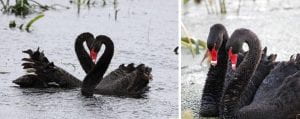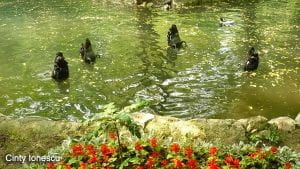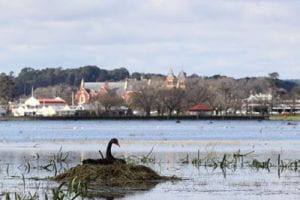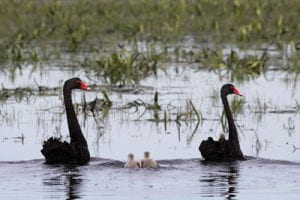- I’ve seen two swans forming a love-heart with their necks. Is this a pair?
No! What you are seeing is in fact two males engaging in a stand-off. In these stand-offs the males will raise their wings to make themselves look as large and intimidating as possible, and then partake in a series of ‘parallel swims’. Eventually one of the two males will concede to the other by swimming away.

- What did European explorers make of black swans?
Black Swans were first seen by Europeans in 1697, when Willem de Vlamingh’s expedition explored the Swan River, Western Australia. At that time, Europeans refused to believe in their existence and were only convinced once de Vlamingh managed to dispatch a couple of specimens to Batavia.
- Where do black swans live?
Black swans are endemic to Australia, and breed primarily on wetlands in south-eastern and -western Australia and nearby coastal islands, covering a range of between one and ten million square kilometers. They are rarely found in northern Australia and the centre.
Black swans also originally also occurred in New Zealand, but were hunted to extinction there before being reintroduced in the mid-1860s. They have also naturally recolonised parts of New Zealand. They are common on a variety of coastal and inland lakes.
There are feral populations of black swans in many parts of Europe and in the US, where they are popular ornamental birds.
- Is it true that a blow from a swan’s wing can break bones?
When swans, their nest or young are threatened, they defend themselves by beating their adversary with rapid blows of their wings. The join of the wing has a very hard bone called the carpal bone, which can certainly hurt and cause bruising if the bird lands a blow. However, cases of broken arms or other broken bones are extremely rare and typically involve people with weak bones, such as children or elderly people.
- How long do black swans live for?
In the wild, black swans face many hazards, especially in an urban environment (foxes, uncontrolled dogs, overhead cables, fishing tackle injuries, cars and pollution). Under these circumstances a lifespan of 10-15 years is normal. However, in a protected environment (e.g. in zoos), black swans have been known to live for 30 to 40 years
- What do black swans eat?
Black swans are almost entirely vegetarian. They feed mainly on algae and submerged weeds, which they pull up by ‘updending’ – tipping forward and reaching their long necks down below the surface, their bottoms in the air and their legs comically waggling in the air. In shallower water black swans are able to dabble – filter-feeding at the water’s surface, or dip its head to feed on plants just under the water’s surface. When conditions are good it is also common to see black swans grazing on pasture on shore.
- Do black swans pair for life?
Male and female black swans form long and mostly enduring pair bonds that last for many years. However, if one of the pair dies, the widowed partner will generally find itself a new mate within six months or so. About one in twenty pairs also divorce – the male and female both survive but form new partnerships with other birds.
Even though pairs show strong social fidelity, a cob cannot always be sure that he is the father of all of the cygnets in his brood. A raft of recent studies has shown that infidelity is rife among birds, even in species where males and females form lifelong pair bonds. By taking small blood samples from swans as part of the routine capture procedure, we have been able to assess patterns of paternity by analysing their DNA. It turns out that about 15 per cent of all cygnets are not sired by their social ‘father’, but by another cob in the population.
- When and where do black swans breed?
Black swans may nest at any time of year, although the peak of breeding activity in south-eastern Australia tends to be between June and November.
The nest is a large platform of weeds and other debris, about 1-1.5m in diameter and up to 1m high, usually on islands, in shallow water or at the water’s edge. Nests are not generally re-used, but are built from scratch in each new year.
The clutch contains between 4 and 11 eggs which are pale green-white in colour, and which are laid at intervals of 1-2 days. Incubation typically commences only when the clutch has been completed, and lasts for 35-40 days. The male and the female both contribute to incubation, with the male typically taking the day shift, while the female incubates at night.
Both sexes are highly aggressive in defending the nest and will attack any oncomer with vigorous beats of their powerful wings.
- How can you tell a male swan from a female?
- How do black swans mate?
An elaborate ritual precedes and follows mating. Either the male, or the female, may approach its mate with its neck stretched out low over the water, at times dipping it under the surface. This is a cue for its partner to respond with identical behaviour. As the two birds come together, the aquatic ballet begins in earnest. The swans now cross their necks and commence neck-dipping in synchrony for up to 20 minutes, each gracefully curved neck arched over the body of its partner. The copulation that follows this flawless choreographic routine is almost comically clumsy by comparison. The male grasps a tuft of feathers on the female’s neck for purchase and heaves himself laboriously onto her back. Given that he is considerably heavier, his weight causes her to sink beneath the surface. After a few seconds (during which insemination presumably takes place under water) the female extends her neck, calls loudly and struggles to the surface, leaving the male to slide ingloriously back into the water. John Mewett has taken a remarkable sequence of photographs (see below) documenting this mating ritual.



